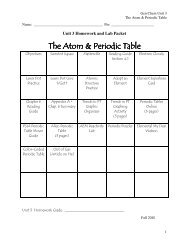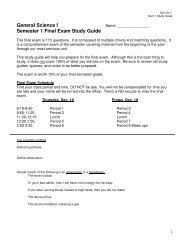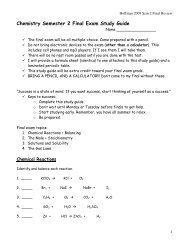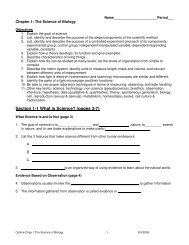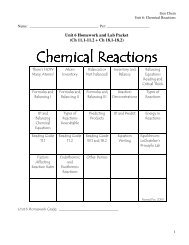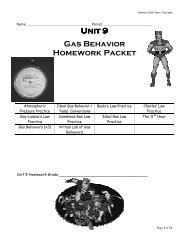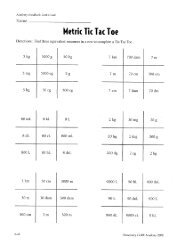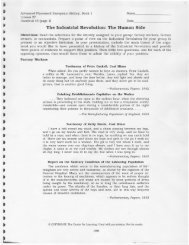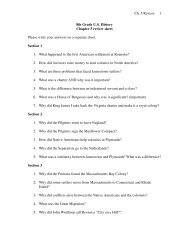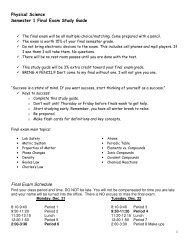M atter and Energy
M atter and Energy
M atter and Energy
Create successful ePaper yourself
Turn your PDF publications into a flip-book with our unique Google optimized e-Paper software.
Gen ChemUnit 2: M<strong>atter</strong> <strong>and</strong> <strong>Energy</strong>1. Define physical property _________________________________________________________________________________________________________________________________________________________2. What are two physical properties that iron <strong>and</strong> copper have in common?____________________________________________________________________________________________________________________________________________________________________________________3. Do all gases have any similar properties?_________________________________________________________________________________________________________________________________________4. Do all solids have any similar properties?________________________________________________________________________________________________________________________________________5. Do all liquids have any similar properties? ______________________________________________________________________________________________________________________________________6. If we froze the water, what physical properties would change? What would stay thesame?____________________________________________________________________________________________________________________________________________________________________________________7. If we boiled the water until it all evaporated, what physical properties would change?What would stay the same?____________________________________________________________________________________________________________________________________________________________________________________4
Data Table:Unknown Liquid NumberGen ChemUnit 2: M<strong>atter</strong> <strong>and</strong> <strong>Energy</strong>Mass of Empty Graduated Cylinder (g)Measurement Total Volume (mL) Total Mass (g)(empty cylinder +liquid)1Actual mass (g)(total mass –empty cylindermass_2345PART THREE: DENSITY OF A GASBasic Idea—Did you ever stop to think about the fact that your breath has density? Well, now youcan find out!! You are going to fill a plastic bag with air from your lungs. Then you will find the mass<strong>and</strong> volume of the air. Follow the directions below.Procedure:1. Remove ALL the air from the bag <strong>and</strong> then seal it. Find the mass of the bag when it is completelyempty of air. Use the balance.2. Unzip the bag A LITTLE <strong>and</strong> blow air into it. Fill the bag as full as you can <strong>and</strong> then zip it shutquickly. DO NOT POP THE BAG. Find the mass of the bag with the air in it.3. Unzip the bag <strong>and</strong> squeeze out all of the air. Now fill the bag with water. Make sure to fill it asmuch with water as it was with air. Try to keep the bag full of water only. Zip the bag closed again.4. CAREFULLY pour some of the water into a 100mL graduated cylinder until the cylinder is full.Don’t spill any or you will have to start all over again! Keep doing this until the bag is empty. Keeptrack of your total volume by keeping track of how many times you fill the graduated cylinder. Recordthe final volume of the water (which equals the volume of air that you had in the bag!)8
Gen ChemUnit 2: M<strong>atter</strong> <strong>and</strong> <strong>Energy</strong>2. Mercury metal is poured into a graduated cylinder that holds exactly 22.5 mL. Themercury used to fill the cylinder weighs 306.0 g. From this information, calculate thedensity of mercury.Givens:Equation: Substitution: Answer with Units:3. What is the mass of ethyl alcohol that exactly fills a 200.0 mL container? The density ofethyl alcohol is 0.789 g/mL.Givens:Equation: Substitution: Answer with Units:4. A rectangular block of copper metal weighs 1896 g. The dimensions of the block are 8.4cm X 5.5 cm X 4.6 cm. From this data, what is the density of copper?Givens:Equation: Substitution: Answer with Units:5. Calculate the density of sulfuric acid if 35.4 mL of the acid weighs 65.14 g.Givens:Equation: Substitution: Answer with Units:11
Gen ChemUnit 2: M<strong>atter</strong> <strong>and</strong> <strong>Energy</strong>6. Find the mass of 250.0 mL of benzene. The density of benzene is 0.8765 g/mlGivens:Equation: Substitution: Answer with Units:7. Calculate the MASS of a liquid with a density of 3.2 g/mL <strong>and</strong> a volume of 25 mL.Givens:Equation: Substitution: Answer with Units:8. A block of lead has dimensions of 4.5 cm X 5.20 cm X 6.00 cm. The block weighs 1587g. From this information, calculate the density of lead.Givens:Equation: Substitution: Answer with Units:10. Calculate the DENSITY of a 500 g retagular block with the following dimensions(measurements): length = 8 cm, width = 6 cm, height = 5 cm.Givens:Equation: Substitution: Answer with Units:12
Density Problems 2Gen ChemUnit 2: M<strong>atter</strong> <strong>and</strong> <strong>Energy</strong>Directions: Answer the questions <strong>and</strong> solve the problems. Show your work for each problem <strong>and</strong>circle your answer. Do not forget to include your units on your answer!Formulamassdensity = -----------volumeHow to find DENSITY:1. Measure the VOLUME <strong>and</strong> MASS of the sample.2. Calculate the sample’s DENSITY with the formula.Water sample: mass 1g, volume 1mLQuestions:1. What is the density of water? ______________2. In an oil spill, the oil seems to float on top of the water. Does oil or water have the lower density?___________3. In an oil spill, is the danger greater to birds <strong>and</strong> marine mammals than it is to fish <strong>and</strong> otherorganisms that live on the ocean bottom? Why?________________________________________________________________________________________________________________________________4. How is the density of oil an advantage in the cleanup?________________________________________________________________________________________________________________________________5. Corn syrup sinks when poured in water. Does water or corn syrup have the higher density?____________6. Why would an oil spill be an even greater disaster if the density of oil were the same as that ofcorn syrup? ________________________________________________________________________________________________________________________________________________________________________________________________13
Defy Gravity Using Density!!!Gen ChemUnit 2: M<strong>atter</strong> <strong>and</strong> <strong>Energy</strong>Intro:George Jetson Superman The Great GazooThey were all able to defy gravity. Now you too will have this power. You simply need toutilize your knowledge of density to make this possible!!!Materials:• Electric Balance• 3 film canisters• Large Beaker• small objects of various masses (marbles, paper clips, pennies, etc.)•rulerProcedure Part 1:1. Using the materials at your desk, modify three film canisters so that they will float,sink, or remain suspended in the middle of a tub of tap water.• The first canister should FLOAT on the top of the water.• The second canister should SINK to the bottom of the water.• The third canister should remain SUSPENDED (in the middle) in the water.2. Have your teacher check your canisters before you proceed to the next part. Getyour teacher’s stamp here:14
Gen ChemUnit 2: M<strong>atter</strong> <strong>and</strong> <strong>Energy</strong>Procedure Part 2:1. Once you have completed Part 1, use the equipment provided to find the mass <strong>and</strong>volume of each canister.2. Record the information in Table 1.3. Calculate the volume of a canister using the formula V=Πr 2 h3. Calculate the density for each canister using the formula D=M/VData Table 1: Mass <strong>and</strong> Volume of film canisters (Be Sure to use units)Canister Mass Volume123Analysis <strong>and</strong> Results:Calculate the densities of canister 1, 2 <strong>and</strong> 3 belowCanister Mass (g) Volume (cm 3 ) Density (g/cm 3 )12315
Gen ChemUnit 2: M<strong>atter</strong> <strong>and</strong> <strong>Energy</strong>1. What is the density of the suspended film canister? Why did it not sink or float?________________________________________________________________________________________________________________________________________________________________________________________________2. If we wanted to make a larger canister be suspended, what would we have to do to thecontents of the canister?________________________________________________________________________________________________________________________________________________________________________________________________3. What is the unit of the density of water?________________________________________________________________________________________________________________________________________________________________________________________________4. What was the unit of the density for the film canisters?________________________________________________________________________________________________________________________________________________________________________________________________5. How are we able to compare these? Aren’t these different units?________________________________________________________________________________________________________________________________________________________________________________________________________________________16
Density saves the day!!Colorado Department of EducationGen ChemUnit 2: M<strong>atter</strong> <strong>and</strong> <strong>Energy</strong>Here is the traditional story:Hiero, king of Syracuse in the third century B.C., gave a jeweler a bar of gold <strong>and</strong> ordered thejeweler to make it into a crown. When the jeweler delivered the crown to the king, the king measuredthe mass of the crown <strong>and</strong> found that the crown had the same mass as the gold he had given thejeweler. Even so, Hiero was suspicious. He believed that the jeweler had cheated him <strong>and</strong> substitutedsome less precious metal for the gold. Hiero asked Archimedes, a natural philosopher, to find a wayto demonstrate that the crown was not pure gold.According to legend, Archimedes struggled with the problem for a very long time. Then, oneday, as he stepped into a bathtub filled with water, he saw that the water overflowed. He noticed thatthe amount of water that overflowed the tub was proportional to the amount of his body that wassubmerged.. He had found the answer <strong>and</strong> ran from the bathhouse crying, .Eureka!. (.I have foundit!.)Remembering that Archimedes knew nothing of density, let us see if we can figure out howwater splashing out of a bath tub led Archimedes to a solution of his problem: testing whether or notthe jeweler had cheated the king.Archimedes ReasoningArchimedes reasoned that (1) if the gold bar <strong>and</strong> the crown had the same mass <strong>and</strong> (2) if bothhad the same volume, then the crown was pure gold. Archimedes reasoned that the volume of waterdisplaced by the crown should be the same as the volume of water displaced by the bar of gold.However, if the gold bar <strong>and</strong> the crown were the same mass but had different volumes, then hereasoned the crown was not pure gold, <strong>and</strong> the jeweler was a fraud.17
What Archimedes MeasuredGen ChemUnit 2: M<strong>atter</strong> <strong>and</strong> <strong>Energy</strong>MassVolumeReal Gold 1000 g 100 mlCrown 1000 g 50 mlWhat Archimedes AssumedThe gold crown should displace the same volume of water as the gold Hiero had given the jeweler.What Archimedes FoundArchimedes found that the jeweler.s crown displaced more water than the gold block.Archimedes. Argument (Explanation)Archimedes reasoned that a gold crown should displace the same volume of water as the asthe gold Hiero had given the jeweler. However, if it was not pure gold, but a silver alloy as the kingsuspected, that would increase the volume of the crown <strong>and</strong> displace more water. He observed thatthe jeweler.s crown displaced twice the volume of water displaced by the gold <strong>and</strong> concluded that thejeweler.s crown was not made from gold.Thus, Archimedes showed that water displacement was a good method for measuring thevolume of irregular objects (as Archimedes certainly was!). An object immersed in water will displacea volume of water equal to the volume of that object.18
Questions to Accompany Reading PassageGen ChemUnit 2: M<strong>atter</strong> <strong>and</strong> <strong>Energy</strong>1) The main idea of this piece of writing is:a) Hiero was the king of Syracuse in the third century B.C.b) The gold crown was a fake.c) Archimedes used water displacement to solve a problem.d) The mass <strong>and</strong> the volume of the crown was different than that of gold.2) Which of these statements could be inferred from the reading?a) Archimedes liked gold.b) Archimedes was a king of Syracuse.c) Archimedes studied science <strong>and</strong> math.d) Archimedes was a jeweler <strong>and</strong> made a crown for the king.3) After reading the article, a good conclusion would be:a) Archimedes solved the king.s problem.b) Water displacement can find the volume of an object.c) The jeweler.s crown displaced more water than the gold block.d) The king decided to hire Archimedes.In your own words, describe how Archimedes knew the king’s crown was notmade of solid gold (5 Sentences).______________________________________________________________________________________________________________________________________________________________________________________________________________________________________________________________________________________________________________________________________________________________________________________________While walking by the Mississippi river, I found a rock that looks like gold!! I’mrich, no more teaching… Describe how I would double check to make sure therock is real gold before I quit my job (4 sentences).__________________________________________________________________________________________________________________________________________________________________________________________________________________________________________________________________________________________________________________19
Gen ChemUnit 2: M<strong>atter</strong> <strong>and</strong> <strong>Energy</strong>Density Problems 3 Directions: Solve the problems. Show your work <strong>and</strong> circle youranswer. Do not forget to include your units on your answer!mass = density X vol.How to find MASS:1. Measure the sample’sVOLUME.2. Use a book to find the sample’sDENSITY3. Use the formula above tocalculate the sample’s MASS.massvolume = ------------densityHow to find VOLUME:1. Measure the sample’s MASS.2. Use a book to find the sample’sDENSITY3. Use the formula above tocalculate the sample’s VOLUME.Problems:1. A certain plastic bracelet has density of 0.78g/ml. Would this bracelet float or sink inwater? ___________ How do you know?________________________________________________________________________________________________________________________________________2. If the density of a diamond is 3.5g/ml, what would be the mass of a diamond whosevolume is 0.5 ml?Givens:Equation: Substitution: Answer with Units:3. Pure gold has a density of 19.32 g/ml. How large (volume) would a piece of gold be if ithad a mass of 318.97 g?Givens:Equation: Substitution: Answer with Units:4. How many mL would a 55.932 g sample of copper occupy if it has a density of 8.92g/mL?Givens:Equation: Substitution: Answer with Units:20
Gen ChemUnit 2: M<strong>atter</strong> <strong>and</strong> <strong>Energy</strong>5. What is the mass of ethyl alcohol that exactly fills a 200.0 mL container? The density ofethyl alcohol is 0.789 g/mL.Givens:Equation: Substitution: Answer with Units:6. Find the mass of 250.0 mL of benzene. The density of benzene is 0.8765 g/mL.Givens:Equation: Substitution: Answer with Units:7. What volume of silver metal will have a mass of exactly 2500.0 g. The density of silver is10.5 g/mL.Givens:Equation: Substitution: Answer with Units:8. The density of lead is 11.342 g/mL. What would be the volume of a 200.0 g sample ofthis metal?Givens:Equation: Substitution: Answer with Units:21
Heat <strong>Energy</strong> HuntGen ChemUnit 2: M<strong>atter</strong> <strong>and</strong> <strong>Energy</strong>Directions: Read the statements below. Move around the room <strong>and</strong> find another person. Askhim/her to do one of the tasks. The person must be able to do it correctly in order to sign your paper.Thank the person <strong>and</strong> find a new partner to repeat the process. Continue until all answer boxes arecompleted. EACH PERSON MAY ONLY SIGN ONCE.# 7 Task Signature Answer1. knows the boiling point of water indegrees Fahrenheit2. can convert 10 degrees Celsius toKelvin3. knows the silver liquid metal in athermometer4. can write the equation needed toconvert Kelvin to Celsius5. Can use his/her body to showwhat happens to the KE as asubstance is heated.6. knows the name of the phasechange where a solid goes to agas without becoming a liquid7. can explain the differencebetween kinetic energy <strong>and</strong>potential energy8. can explain what is happening tothe molecules in terms of energyduring a phase change9. can describe the properties of aliquid10. know the difference in degreesCelsius between the freezing point<strong>and</strong> boiling point of water22
Section 2.2 – 2.3 Key Terms (pgs. 44-52)Define terms in your own wordsGen ChemUnit 2: M<strong>atter</strong> <strong>and</strong> <strong>Energy</strong>MixtureHeterogenous mixturehonogeneous mixturesolutionphaseFiltrationElementCompoundChemical changeChemical symbol2.2 + 2.3 Section Review:#12#14#17#2323
Phase Change OrganizerGen ChemUnit 2: M<strong>atter</strong> <strong>and</strong> <strong>Energy</strong>For each of the following phase changes, summarize what is happening on both the macroscopic <strong>and</strong>microscopic level.Phase Change Macroscopic level Microscopic Level Important VocabEvaporation Boiling Point =CondensationMelting Melting Point =FreezingFreezing Point=Sublimation24
H 2 O Phase Changes <strong>and</strong> the Impact of a SoluteGen ChemUnit 2: M<strong>atter</strong> <strong>and</strong> <strong>Energy</strong>Background:1. Kinetic <strong>Energy</strong> = the energy of motion2. Potential <strong>Energy</strong> = stored energy3. Intermolecular Forces = forces that hold molecules together in solids, liquids, <strong>and</strong> gases4. Solvent = does the dissolving; what a substance is dissolved in (water for example)5. Solute = gets dissolved by the solvent; substance that is dissolved (salt for example)MaterialsHot Plate Beaker Ringst<strong>and</strong>Thermometer Ice Test Tube ClampStop Watch Stirring RodHow to take the temperature for ALL parts:1. NEVER stir the solution with the thermometer. It costs $10 more than a glass stirring rod <strong>and</strong> willruin your data if it breaks.2. ALWAYS use a glass stirring rod to stir.3. Stir the solution before taking your temperature.4. Do not let the glass bulb of your thermometer touch the bottom of your beaker.5. Do not let the glass bulb of your thermometer come out of the water or icewater.Part 1:1. Fill a 400mL beaker three-quarters full with ice.2. Record the temperature every 30 seconds for 7 minutes. Record your temperature in your datatable. REMEMBER: stir before taking the temperature.3. While keeping your time running, after 7 minutes, place the beaker on a hot plate.4. Set the hot plate between medium <strong>and</strong> high (do NOT place the hot plate on 10).5. Continue to record the temperature every 30 seconds. Your water should come to a full boil.6. Stop recording your temperature after 40 minutes.Phase changes of WaterHotplate Time in minutes Temperature in o CNo Hotplate 0.00.51.01.52.02.53.03.54.04.55.05.56.06.57.0Hotplate 7.58.025
Continue the data table to 40minutes8.59.09.510.0Gen ChemUnit 2: M<strong>atter</strong> <strong>and</strong> <strong>Energy</strong>Part 2:1. Fill a 250mL beaker with 100mL of distilled water.2. Bring the water to a boil. Take the temperature of the water <strong>and</strong> record the temperature in yourdata table.3. Remove the thermometer from the water. Wait 1-2 minutes <strong>and</strong> take <strong>and</strong> record the temperatureof your boiling water again. Make sure that the temperature on your thermometer has dropped closerto room temperature before you place it back into the water.4. Wait another 1-2 minutes with the thermometer out of the beaker. Again, take <strong>and</strong> record thetemperature.5. Add 15g of salt to you beaker of water. Bring the water to a boil again, making sure to stir the saltso that it is completely dissolved.6. Repeat steps 2-4 with the salt water.Boiling Point of Water with <strong>and</strong> without solute (NaCl/table salt)Solution Temp 1 ( o C) Temp 2 ( o C) Temp 3 ( o C)No Salt15g SaltPart 3:1. Fill a 250mL beaker with 100mL of ice.2. Add 25mL of water.3. Stir the solution for 2 minutes with a stirring rod.4. Record the temperature for the ice water <strong>and</strong> record the data in your data table.5. Remove the thermometer from the ice water. Wait 1-2 minutes <strong>and</strong> take <strong>and</strong> record thetemperature of the ice water again. Make sure that the temperature on your thermometer hasdropped closer to room temperature before you place it back into the ice water.6. Wait another 1-2 minute with the thermometer out of the beaker. Again, take <strong>and</strong> record thetemperature.7. Empty the beaker <strong>and</strong> again fill it with 100mL of ice <strong>and</strong> 25mL of water. Now add 15g of salt.8. Repeat steps 3-6 <strong>and</strong> record your data.Melting Point of Water with <strong>and</strong> Without Solute (NaCl/table salt)Solution Temp 1 ( o C) Temp 2 ( o C) Temp 3 ( o C)No Salt15 g Salt26
QuestionsGen ChemUnit 2: M<strong>atter</strong> <strong>and</strong> <strong>Energy</strong>1. Make a graph for your data from Part 1.-label all phases <strong>and</strong> phase changes-with your pen or pencil, add a line for gas (steam)2. Using your graph you drew in question 1, when did the temperature start to rise rapidly? (Hint: itprobably did not happen at the seven minute point).Copy the following graph into your lab report <strong>and</strong> use it to answer questions 3-5.100 o C0 O C3. Indicate (on the graph) where potential energy is highest.4. Indicate (on the graph)where intermolecular forces are highest.5. Indicate (on the graph)where kinetic energy is increasing.6. What does a solute do to the boiling point of water?7. What does a solute do to the melting point of water?Conclusion:• Restate purpose• Was the purpose achieved or was it not? Support your decision with data.• What principle of chemistry did this lab show? Make sure to relate it to what we are coveringin class.• Two errors that you had in the lab <strong>and</strong> how they effected your data.• Two mistakes that you had in the lab <strong>and</strong> how they effected your data.27
Phase Change Diagram WorksheetGen ChemUnit 2: M<strong>atter</strong> <strong>and</strong> <strong>Energy</strong>1. Does the temperature increase during boiling? _______________________2. Does potential energy change during a phase change? _________________3. Can both liquid water <strong>and</strong> ice exist at 0 o C? ___________________________4. What must be changed, temperature or heat energy, during melting?________________________________________________________________5. Describe the change in the arrangement of particles as potential energy increases <strong>and</strong> the phasechanges.________________________________________________________________6. What rule can you state about the relationship between kinetic energy <strong>and</strong> temperature?________________________________________________________________28
I Scream! You Scream! Gen ChemUnit 2: M<strong>atter</strong> <strong>and</strong> <strong>Energy</strong>!" 0!!! 0!!"! 4 "1! # 8 1 8 9 ! 1 0 -"(! -"(! 8 : !$ 0!(!!%(;* !&*< ( 3(=( ->?(! 1!*@A!% &A((* 0(!!%( @&=; ?18 % &1A(39 !% @&=; ? (!!%!!( 1(!!! A% &A(> ,(! 1.(!(! A !(!!!!(@ 1(!!(11A1(! 1 (! &(!=1? (29
Gen ChemUnit 2: M<strong>atter</strong> <strong>and</strong> <strong>Energy</strong>(!1!(1*
. &Gen ChemUnit 2: M<strong>atter</strong> <strong>and</strong> <strong>Energy</strong> $ ( !1! / !(G* 0!1% (G> / G@ / 1!-A!GB 0(" 1!"! ,A 1 1 AH,A.5/ ( G31
Chemical versus Physical Change SurveyGen ChemUnit 2: M<strong>atter</strong> <strong>and</strong> <strong>Energy</strong>1DirectionsDissolve 2g of NaCl in50ml of waterChemicalchangePhysicalChangeorEvidence of physical or chemicalchange.2Tear a piece of scrappaper. Save it.3Light the piece of scrappaper (C 30 H 62 O 12 ) <strong>and</strong>place it in a watch glass.4Put 2 ice cubes in apaper towel <strong>and</strong> crushthem with an iron ring.5Boil 30ml of water in asmall beaker.6Invert a test tube <strong>and</strong>collect the steam.7Put a small drop of zincin a test tube. Add 10drops of sulfuric acid.8910Observe the solid iodineinside the stopperedflask at the front of theroom.Place 10ml of water in atest tube. Add one dropof food coloring to thewater.Heat a test tube until thewater is gone.32
11121314Light a c<strong>and</strong>le wick(C 25 H 52 ).Drip wax on a glasssquare.Put three drops ofethanol on the table.Blow on them until theethanol is gone.Place 10 drops ofpotassium chromate in atest tube. Add threedrops of copper IIchloride.Gen ChemUnit 2: M<strong>atter</strong> <strong>and</strong> <strong>Energy</strong>Questions:1. Classify the following as chemical or physical changes.Example Action Classification1 Breaking Glass2 Frying an egg3 Adding sugar to milk4. Coloring a coloring book5. Boiling ethanol6. Igniting ethanol2. What happens to molecules of water during a physical change?3. What happens to molecules of sugar during a chemical change?33
Elements, Compounds, <strong>and</strong> MixturesPhysical Science in ActionGen ChemUnit 2: M<strong>atter</strong> <strong>and</strong> <strong>Energy</strong>Directions: Answer the following questions while watching the video. Make sure to answer in full <strong>and</strong>complete sentences <strong>and</strong> use the knowledge that you gain from the video.1. What are the main parts of the atom? Where are they located within the atom?2. What makes one element different from another?3. How many protons are in a copper atom?4. What is a property of copper that makes it useful to people?5. About how many elements are there naturally on Earth? How many elements are man-made?6. What is the most common element in the universe?7. What are the most common elements found on Earth?8. How many substances are known to exist on Earth?34
9. What is a compound? How is it different from an element?Gen ChemUnit 2: M<strong>atter</strong> <strong>and</strong> <strong>Energy</strong>10. What is a chemical bond?11. What is the difference between a mixture <strong>and</strong> a compound?12. What is a heterogeneous mixture? What are some examples?13. What is a homogeneous mixture? What are some examples?14. How does something dissolve?15. What is a solution?16. How is glass made? From what elements is most glass formed? Is glass a compound or amixture?35
Elements, Compounds, <strong>and</strong> Mixtures Survey LabDirections: Look at the following 20 items that are laid out on the lab tables. Identify each as anelement, a compound, a homogeneous mixture, or a heterogeneous mixture. After you haveclassified the item, write/explain your reason for the classification.Purpose: ________________________________________________________________________________________________________________________________________________________________________________________________.E=element, C=Compound,Homo=homogeneous mixture, Hetero=heterogeneous mixtureNumber Item E, C, Homo, Reason for ChoiceHetero1.2.3.4.5.6.7.8.9.10.36
11.12.13.14.15.16.17.18.19.20.Questions:1. Give two scenarios where coffee would be heterogeneous, the other homogeneous.2. Classify steel <strong>and</strong> explain your reason (you may have to look this one up37
Analysis of Drugs <strong>and</strong> PoisonsA forensic science investigationObjectives• Evidence, models, <strong>and</strong> explanation• Change, constancy, <strong>and</strong> measurement• Underst<strong>and</strong>ings <strong>and</strong> abilities about scientific inquiry• Properties <strong>and</strong> changes of properties in m<strong>atter</strong>• Chemical reactions• Natural <strong>and</strong> Human induced hazardsExperiment 1Over-The-Counter DrugsVarious tests will be carried out on the unknowns <strong>and</strong> compared to the results of the same testson some common over-the-counter drugs.Materials NeededUnknown Powders A <strong>and</strong> BAspirin <strong>and</strong> TylenolAlka-SeltzerFerric nitrate solutionSodium bicarbonateDistilled waterUniversal Indicator <strong>and</strong> chart Depression plate0.5 M HCl ToothpicksProcedure1. In a horizontal row on the depression plate, place a few granules of aspirin into 3depressions on the plate. Use a pencil to label this row with code “A” for aspirin.2. Repeat Step 1 for each of the powders, including Alka-Seltzer, Tylenol, Crime SceneUnknown A <strong>and</strong> Crime Scene Unknown B, <strong>and</strong> sodium bicarbonate powders making surethat they appear on the plate in the same order as the appear on the Data Sheet. Markevery row with a code.3. Observe the appearance of each powder noting its color <strong>and</strong> consistency. Record yourobservations on the Date sheet. (White, fine, granular, crystalline, etc.)4. Add 5 drops of distilled water to each powder in column 1. Do any reactions begin tooccur? Why? Record results in your data table. (no reaction-NR, bubbles, dissolves,effervesces, etc.)5. Add 2 drops of Universal Indicator to each of the depressions containing the powders inthe same column with water. Let set for 3 minutes for color to run. Use a differenttoothpick to stir each one. Which are reddish in color? Which are yellow-green? Whichare red/orange? Record the color of each <strong>and</strong>, using the color chart, record if the sampleis acidic, neutral, or basic. Can you explain the results?38
6. Add 1 or 2 drops of the hydrochloric acid solution to each of the powders in column 2. Isthere any fizzing? Which powders are producing carbon dioxide gas? Record results.7. Add 1 or 2 drops of the ferric nitrate solution to each of the powders in column 3. Use atoothpick to stir the solution. Have any produced a purple color?8. Carefully discard all the solutions into the sink <strong>and</strong> rinse the plate twice with water. If anymaterial remains, use a test tube brush to gently scrub the depression taking care not topoke a hole in the plate.9. Using all of the above results, what is the identity of the white powder found at the “scene”of the crime? Which test results best support your answer?Experiment 2Identification of Simulated Controlled DrugsA. Examination of Simulated LSDMaterials NeededSimulated LSDUltraviolet LightProcedure1. Carefully shine an ultraviolet light on the bag of simulated LSD. There is no need toremove the material from the bag. Are there any fluorescent areas? Record observations.CAUTION! DO NOT look directly at the ultraviolet light or it could cause harm to theeyes! Shine the light directly on the sample <strong>and</strong> do not allow the light to fall on theeyes of classmates.2. Compare all the other bags of powder. You should see that the Alka-Seltzer is veryfluorescent.39
Experiment 3Detection of heavy Metal PoisonMaterials NeededUnknown “Heavy-metal”Mercury solutionPotassium chromate solutionLead solutionDepression plate3 test tubes w/ corksProcedure1. Place 2 drops of the lead solution into one of the depressions on the plate. Add 2 drops ofthe potassium chromate solution. Record your observations.2. Repeat Step 1 with the mercury solution <strong>and</strong> the solution containing the “unknown heavymetal.” Record the results. Which heavy metal is contained in the unknown?3. Carefully rinse the solutions <strong>and</strong> solids into the drain <strong>and</strong> rinse the plate twice with distilledwater.Reactions represented:Pb(NO 3 ) 2 + K 2 CrO 4 PbCrO 4 + 2KNO 3Hg 2 (NO 3 ) 2 + K 2 CrO 4 Hg 2 CrO 4 + 2KNO 3Experiment 4Determination of Poisoning through Analysis of Amino Acids in Simulated UrineMaterials NeededSimulated urine unknownSimulated urine alanineSimulated urine glycineCapillary tubesChromatography paperButanolAcetic acidNinhydrin16 x 125 test tube Q-tip (to dab ninhydrin solution)Heat lamp, hair dryer, or ovenAcetoneCAUTION: Most of the liquids used in this experiment are volatile <strong>and</strong> flammable.Keep them away from open flames <strong>and</strong> DO NOT inhale the vapors.NOTE: Due to instability over long periods of time, the ninhydrin should be used on thesame day it is prepared. Do NOT get the ninhydrin on your skin. It will turn the skin ablue color <strong>and</strong> it will remain that way for some time.40
Procedure1. Obtain 3 strips of chromatography paper. Draw a pencil line across each strip 1 cmfrom the bottom of the paper. Mark “G” at the top of one strip, <strong>and</strong> “A” at the stop ofthe second <strong>and</strong> “U” at the top of the third.2. Place 1 drop of simulated urine glycine in the depression plate. Use a capillary tube todeposit a tiny drop on the middle of the pencil line on the “G” strip.3. Repeat Step 2 using the simulated urine alanine solution <strong>and</strong> placing a drop on strip“A”.4. Repeat Step 2, placing a drop of the simulated urine unknown on the strip marked “U”.Let them all dry.5. Get three test tubes. Obtain a small amount of carrier solution prepared by yourteacher. Place enough of this solution into each of the 3 test tubes so that it is nohigher than 0.5 cm.6. Carefully place each of the strips into a separate tube. Place a small piece ofcellophane tape across the top to prevent fumes from escaping. Allow the solvent totravel at least half-way up the strips <strong>and</strong> mark how far the solvent traveled.7. Allow the strips to dry <strong>and</strong> then place them on a paper towel. Using the preparedninhydrin solution provided by your teacher, use a Q-tip to carefully dap the strips withthe solution. Allow the strips to dry in an oven. The spots of the amino acids shouldshow up in a few minutes.8. Using the similarities in the strips identify the type of heavy metal poisoning.Experiment 5Analysis of Unknown White Powders from Crime SceneEach group will now analyze the unknown X, Y, <strong>and</strong> Z from the scene of a crime. Refer back toprocedures 1, 2, <strong>and</strong> 3 for help.MaterialsUnkwnown powders X, Y, ZUniversal indicatorFerric nitrate solutionDepression plateHydrochloric acidPotassium chromate solutionUltraviolet lightCAUTION! Do NOT touch the unknown powder. Use a pair of forceps or a scoopula.1. Obtain a small piece of each unknown <strong>and</strong> place them on a labeled piece of paper.2. Shine the ultraviolet light onto each powder. Record your results <strong>and</strong> draw conclusion.3. Place a few grains of each unknown into 4 depressions on the plate. Start with 5 drops ofwater in the first well. Record your results. Then add 5 drops of universal indicator to thefirst sample with water, hydrochloric acid to the second well, ferric nitrate to the third, <strong>and</strong>potassium chromate to the fourth. Be sure to record your results.41
4. Observe what happened in each depression. Based on previous observations from priorexperiments, what is the identity of the unknown powders?5. Clean the well plate by rinsing it twice with distilled water.Data Tables will be h<strong>and</strong>ed out to each student.42
Reading Guide: Section 3.3, p.80-87Using the pages listed above in your textbook, use this completion exercise to check yourunderst<strong>and</strong>ing of the concepts <strong>and</strong> terms that are introduced in this section. Each blank can becompleted with a term, short phrase, or number.Whenever two measurements are equal, orequivalent, a ratio of these two measurements willequal ____1____. A ratio of equivalentmeasurements is called a ___2___. When ameasurement is multiplied by a conversion factor,the value of the measurement ___3___.In ___4___, the units that a part of themeasurements are used to help solve the problem.The form of the conversion factor that is used is theone in which the unit of the ___5___ is in thedenominator.Many complex word problems can be solved bybreaking the solution into ___6___. Whenconverting between units, it is often necessary touse more than one ___7___.In doing multistep problems, it is important tocheck that the numerator <strong>and</strong> ___8___ of eachconversion factor are equivalent. When the __9__cancel, you should be left with the unit of the _10_.1. __________________________2. __________________________3. __________________________4. __________________________5. __________________________6. __________________________7. __________________________8. __________________________9. __________________________10. __________________________Page 821) Read Sample Problem 3.5.2) Complete #28 showing your work below:Page 831) Read Sample Problem 3.62) Complete #30 showing your work below:Page 861) Read Sample Problem 3.92) Complete #36 showing your work below:43
Dimension Analysis (Factor Label) Practice 1Answer the problems below. SHOW YOUR WORK!1. How many golf balls would there be in a 2.5 ton sample of golf balls? (One golf ballweighs 4.0 oz)2. What is the volume of mercury that has a mass of 1.0 kg? (The density of mercury is 13.5g/cm 3 )3. The density of water is 1.00 g/cm 3 . Express this density in lb/ft 3 .4. A 200 mg tablet of vitamin C is how many ounces?5. A car traveling 70 mph has a speed of how many meters per second?44
Dimensional Analysis Practice 2Answer the problems below using dimensional analysis. SHOW YOUR WORK!1. Find the mass in grams of a diamond that is ¾ carat (0.750 carat). (Given: 1 carat= 0.200gram).2. Find the mass in grains of a 325 mg aspirin tablet. (Given: 1000 milligrams = 15.4 grains).3. For the ice cream lab we need to use cream. Find the number of cups of cream in 2.5pints. (Given: 1 pint= 2 cups).4. Calculate the number of months in 3.25 years.5. How many meters does light travel in 1 year? (Given: The velocity of light is 3.00x10 8 m/s).45
Chemistry: The Mathematics of ChemistryName:_______________________Hour: ____ Date: ___________Complete the following calculations. Include units on your answers.1. (127 m)(23 s)2. (5.22 m) (4.29 m)3. 34 cm + 21 cm + 8 cm4. (0.45 mm) (0.28 mm) (0.85 mm)5. (10 kg) (30 m)(5 s)6. 1.3 moles3.4 L7. (75 kg) (5.25 m)(2.5 s) (6.3 s)8. (56 N) (2.5 m)9. (1.27 J + 0.22 J)(116 g) (4.8 o C)10. (7.54 N) (0.246 m)(0.672 s)11. (8.13 kg)(0.452 cm) (0.550 cm)12. 54.0 g4.10 L46
Simplify the following expressions.13. 5 (5w – 4w)1014. 1304 x 7.631 x 4.000(521.2) (0.4998)15. (3.28d) (4.83d) (0.250)Solve each of the following expressions for x. (x = ??)16. 2x – 14 = 817. 4x – 2z = 3y + 8 (if y = 12 <strong>and</strong> z = –3)18. H = WQx19. x + 12 = 23FG20. 18KRx = EF 221. T = LxS22. 15G – x = U23. Y = T + 6X47
Chemistry: Real Life Chemistry (for the Business World)You work for Gateway as a purchasing agent. You are responsible for ordering certain parts for the newest modelsystem. The following information is necessary for your order:one system requires 12 widgets <strong>and</strong> 48 watzits a watzit weighs 0.50 lbs.one system takes up 2 ft 3 of spacea widget weighs 0.25 lbs.Solve the following problems. Show your work <strong>and</strong> use units for full credit.1. You are making 150 000 systems for next year.a. How many widgets must you order?b. How many watzits must you order?2. a. How much will the widgets weigh?b. How much will the watzits weigh?3. Your warehouse has a volume of 1 000 000 ft 3 . How many systems can you place there?4. You place your original order, but the factory producing watzits can only provide 2500 watzits.How many systems can you produce?5. If the factory producing watzits can only provide 2500 watzits…a. How many widgets will do you need to order now?b. What will the total weight of these widgets be?6. It costs $0.30 per widget <strong>and</strong> $0.50 per watzit, what is the cost of…a. 1 system?b. 150 000 systems?7. If each system sells for $250, how many systems must you sell to earn $1 000 000 dollars profit?48
Chemistry: Scientific NotationPart A: Express each of the following in st<strong>and</strong>ard form.1. 5.2 x 10 3 5. 3.6 x 10 12. 9.65 x 10 –4 6. 6.452 x 10 23. 8.5 x 10 –2 7. 8.77 x 10 –14. 2.71 x 10 4 8. 6.4 x 10 –3Part B: Express each of the following in scientific notation.1. 78,000 5. 162. 0.00053 6. 0.00433. 250 7. 0.8754. 2,687 8. 0.012654Part C: Use the exponent function on your calculator (EE or EXP) to compute thefollowing.1. (6.02 x 10 23 ) (8.65 x 10 4 ) 8. (5.4 x 10 4 ) (2.2 x 10 7 )4.5 x 10 52. (6.02 x 10 23 ) (9.63 x 10 –2 ) 9. (6.02 x 10 23 ) (–1.42 x 10 –15 )6.54 x 10 –63. 5.6 x 10 –18 10. (6.02 x 10 23 ) (–5.11 x 10 –27 )8.9 x 10 8 –8.23 x 10 549



